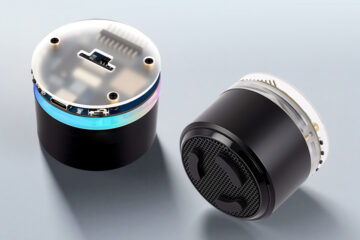The major advantage of the DLNA architecture is it’s clear separation of concerns. This split into specialized roles allows developers to create focused, efficient devices that, when combined, form a sophisticated whole-house audio system. The architecture is built around three core components: Media Servers, which store and distribute (e.g. audio) content; Media Renderers, which receive and play that audio; and Control Points, which act as the intelligent conductors, discovering devices and orchestrating playback between them. This modularity means a resource-constrained microcontroller only needs to implement the services required for its specific role, making the system feasible to build from the ground up.
In addition, the notion of Notifications will make sure that the state across all your controllers will be kept updated, consistent, and actual.
Example Applications
For instance, a microcontroller can excel as a dedicated Audio Media Server. An ESP32, equipped with an internet connection, can function as a robust Internet Radio Stream Server, presenting a browsable list of stations to the network. Similarly, another ESP32 with a microphone can become a Voice Message Server, recording and serving audio memos as if they were tracks in a music library. This turns a simple microcontroller into a distributed audio source, providing content anywhere on the network.
On the output side, the Audio Media Renderer role is perfectly suited for creating distributed speakers. An ESP32 paired with an I2S audio DAC can become a Multi-Room Audio Endpoint, capable of receiving a stream and playing it in perfect synchrony with other identical nodes throughout a home. For simpler applications, an ESP8266 can act as a Notification Speaker, lying dormant until a network command triggers it to play a doorbell chime or an alert tone, leveraging its low power consumption for always-on duty.
The true intelligence of the system resides in the Audio Control Points. These are the interfaces through which users interact with the audio ecosystem. A microcontroller with a touchscreen can become a Whole-House Audio Controller, discovering all available servers and renderers, allowing a user to group rooms, adjust volumes, and select audio sources. For a more minimalist approach, a device with physical rotary encoders and buttons provides a tactile Control Panel, offering immediate, hands-on control without the need for a screen. More advanced still, a Control Point with integrated voice recognition can accept spoken commands, making the entire system accessible without lifting a finger.
The power of this architecture is fully realized when these components are combined into complete systems. A Multi-Room Music System might consist of a radio stream server, several speaker renderers in different rooms, and a central touchscreen control point. A Smart Home Audio Alert System could use the home automation hub as a server for alert sounds, small notification speakers as renderers, and motion sensors as automated control points to trigger location-specific audio warnings. Finally, a Voice Intercom System could be built from multiple devices that each act as both a server (for recording) and a renderer (for playback), with physical buttons to control which room receives the message.
But the real beauty of it is, that you can intgrate your solution with the *already existing applications on Windows, Linux, Android etc
In the next blogs I am planning to show some Arduino Sketches…


0 Comments